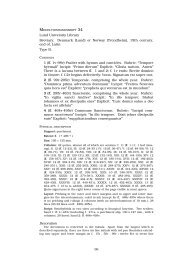Lund University Library Olim - St. Laurentius Digital Manuscript Library
Lund University Library Olim - St. Laurentius Digital Manuscript Library
Lund University Library Olim - St. Laurentius Digital Manuscript Library
You also want an ePaper? Increase the reach of your titles
YUMPU automatically turns print PDFs into web optimized ePapers that Google loves.
2 Medieval <strong>Manuscript</strong> Catalogue Mh 1<br />
Initials in square capitals with some exceptions in uncials, elegantly drawn<br />
mostly in brown ink, contemporary with the main portion of the text. Alarge initial<br />
(S) begins Book II on f. 2v . Secondary initials on ff. 22r and 22v show simple floral<br />
ornamentation.<br />
Detailed description<br />
f. 23r : Full page decoration with a combination of four separate rubricated diagrams<br />
within a common decorated frame, illustration to II:54:9. Above left Geometrica,<br />
a diagram with a horizontal band divided into four with two concentric segments<br />
of a circle above, the outer of which connects the outermost fields, and the<br />
inner, which is divided by a vertical line, connects the two central fields, and below<br />
two intersecting segments connecting the outer fields with the central field in the<br />
opposite half of the horizontal band. Above right Arithmetica, a diagram with a<br />
horizontal band divided into four with two concentric segments of a circle above,<br />
the outer of which connects the outermost fields, and the inner, which is divided by<br />
avertical line, connects the two central fields, and below a larger segment connecting<br />
the far left field with the central right, and a smaller segment connecting the far<br />
right field with the central right. Below left Armonica, a diagram with a horizontal<br />
band divided into two bands of which the upper is divided into four fields with two<br />
concentric segments of a circle above, the outer of which connects the outermost<br />
fields, and the inner, which is divided by a vertical line, connects the two central<br />
fields. The lower band is divided into two and two arches connect the outer parts<br />
of the fields with the division line in the middle. Below right Consonantiae, a diagram<br />
with a vertical band divided into four with a large segment of a circle to the<br />
left connecting the outer fields and three smaller segments connecting the respectively<br />
juxtaposed fields. To the right two intersecting segments connect the outer<br />
fields with the central field in the opposite half of the vertical band. The diagrams<br />
are separated from each other by a cruciform decoration consisting of two parallel<br />
lines transgressing the frame and ending with knobbed sprouts which diverge in<br />
the vertical axis, and intersect in the horizontal axis, and a secondarily enhanced<br />
cross inscribed between these lines with knobs at the ends and in the center.<br />
Short knobbed sprouts of the same kind protrude from the corners of the frame.<br />
In comparison with the luxurious Bamberg manuscript of De Arithmetica, Bamberg<br />
<strong>St</strong>aatsbibliothek, Class. 8(H.J.IV.12), there is a marked absence of independent<br />
artistry in Medeltidshandskrift 1. The simplicity of the diagrammatic decoration<br />
presents us with a neutral complement to the text, common also in astronomical<br />
and geometrical treatises throughout the Middle Ages, without any stylistic features<br />
connecting the decoration with the art historical currents of eastern France<br />
to which the manuscript has been ascribed on palaeographical grounds, or any<br />
other region. There is reason to believe that the attitude towards the diagrams as<br />
part of the text rather than images justified an exact copying of the exemplar<br />
instead of an interpretation in the taste of the day, which makes the only decorated<br />
illustration the more interesting.<br />
The full page diagram on f. 23r displays characteristic protrusions in the<br />
framework. Though simple in design they are distinct enough to say that they do<br />
not convey to the notion of either Franco-Saxon style in particular or late Carolingian<br />
style as a whole, but show closer affinities to insular decoration. The spelling<br />
and abbreviations in the <strong>Lund</strong> manuscript noted by Lehmann seem to confirm the<br />
textual dependence of an insular prototype. Parallels to the frame in this manuscript<br />
are to be found in the evangelist portraits in the Trier Gospels and the<br />
Macregol Gospels. In detail, however, insular book illumination often show a more<br />
elaborated interlace pattern, whereas the simpler kind of knobbed sprouts are<br />
found in late antique works of art in different media.<br />
In comparison to diagrams and schemas in related works on the liberal arts by<br />
Cassiodorus and the Corpus Agrimensorum, with which De Arithmetica was often<br />
associated, there is a striking similarity in execution independent of the manuscript’s<br />
date or place of origin. In the case of the Corpus Agrimensorum, which is<br />
preserved in both 6th century manuscripts and later copies, it can be stated that<br />
the Carolingian artists followed their exemplars very closely. Suggesting that the<br />
same can be suspected of the relation between Medeltidshandskrift 1 and its prototype,<br />
it is likely that its decoration represents a faithful copy ultimately derived














